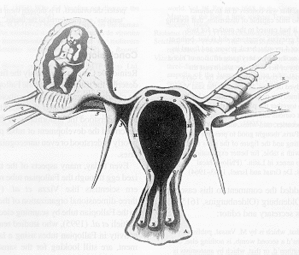Ectopic pregnancy
An ectopic pregnancy is one in which the fertilized ovum is implanted in any tissue other than the uterine wall. Most ectopic pregnancies occur in the Fallopian tube (so-called tubal pregnancies), but implantation can also occur in the cervix, ovaries, and abdomen. more...
Overview
In a normal pregnancy, the fertilized egg enters the uterus and settles into the uterine lining where it has plenty of room to divide and grow. In a typical ectopic pregnancy, the embryo does not reach the uterus, but instead adheres to the lining of the Fallopian tube. As the embryo implants and grows, the tube becomes stretched and inflamed, causing increasing pain in the pregnant woman. If left untreated, the affected Fallopian tube will likely burst, causing gynecologic hemorrhage and endangering the life of the woman. Only 2% of ectopic pregnancies occur outside of the fallopian tubes. About 1% of pregnancies are in an ectopic location.
Causes
Cilia damage and tube occlusion
Hair-like cilia located on the internal surface of the Fallopian tubes carry the fertilized egg to the uterus. Damage to the cilia, or blockage of the Fallopian tubes is likely to lead to an ectopic pregnancy.
Women with pelvic inflammatory disease (PID) have a high occurrence of ectopic pregnancy. This results from the build-up of scar tissue in the Fallopian tubes, causing damage to cilia and possibly tube occlusion.
Tubal surgery, such as tubal ligation (or the reversal thereof), is also likely to cause cilia damage. And because ectopic pregnancy is treated with tubal surgery, a history of ectopic pregnancy increases the risk of future occurrences.
Excessive estrogen and progesterone
High levels of estrogen and progesterone increase the risk of ectopic pregnancy because these hormones slow the movement of the fertilized egg through the Fallopian tube. The use of progesterone-secreting intrauterine devices (IUDs), the morning-after pill, and other hormonal methods of contraception often result in high estrogen and progesterone concentration and may increase the risk of ectopic pregnancy. Ectopic pregnancies are seen more commonly in patients undergoing infertility treatments.
Other
Patients are at higher risk for ectopic pregnancy with advancing age. Also, it has been noted that smoking is associated with ectopic risk. Vaginal douching has been shown to increase ectopic pregnancies.
Symptoms
Patients with an ectopic pregnancy typically have:
- Lower back, abdominal, or pelvic pain.
- There may be cramping or even tenderness on one side of the pelvis.
- The pain is of recent onset, and often getting worse.
- Vaginal bleeding may be present.
- Low serum hematocrit (due to loss of blood)
- Elevated serum human chorionic gonadotropin (due to pregnancy)
Ectopic pregnancy is noted that it can mimic symptoms of other diseases such as appendicitis, other gastrointestinal disorder, problems of the urinary system, as well as pelvic inflammatory disease and other gynecologic problems.
Read more at Wikipedia.org



